

Before I was an exhibiting and selling artist, before I was an Artist, I was a teacher. I started with teaching first grade, which lasted two years, and then moved on to English as a Second Language, which I did for 5+ years.
So it was natural, when I heard of a need for English teachers in East Oakland, for me to sign my name on a clipboard and be standing in front of a classroom two weeks later. The room was vast and dimly lit and stiflingly hot, but the 25 students sitting before me stole my heart in an instant. Mostly young adults from Guatemala, they are learning the basics--pronouns, "to be" verbs, and what to say if a masked officer comes to their door. There's another class in the basement that's getting its instruction from a Spanish speaking teacher, and two classes above mine that are more advanced. Perhaps 50% of our students are very new to this country, and they feel safer attending classes in their neighborhood, rather than attending public adult school classes.The teachers and a dozen or so aides are all volunteers, mostly from my church. We gather two nights a week, and at 8:00 we take a break and eat sandwiches and tamales while their kids run around the playground.
It was also natural that their faces would start appearing in my paintings. I'm creating a series of small 12"x12" portraits in which I try to capture their sincerity and humanity.
So far I've made 25 portraits, but I'm nowhere near losing interest. I am so inspired by their hopefulness and optimism, and teaching and painting them has lifted me from despair in these troubled times. I am so grateful to them. They are my teachers.
I hope to exhibit these portraits in churches and public spaces. If you have any ideas on where I might show these, please, let me know.
I spoke at the Wayne Pres Women's Retreat this weekend (on Transitions) and we used your art cards.The team purchased 100 cards and framed 50 and placed them all around the Chapel for the 50 women in attendance.The frames were double sided, so many women chose two pieces.Your art opened the women to understand, share and articulate what was stirring in them in astonishing ways.I wished you could have seen the emotion, connection, epiphanies...
I love working on paintings in the privacy of my studio, telling myself that no one will see the finished work except myself, tricking myself to paint honestly. Doing this installation challenged me to dialogue and compromise at times, but I felt like I learned so much and felt a deeper bond with the member who struggled with the piece initially. And I love seeing congregants interact with the piece after the church services.
On Easter Sunday I added a dove.
Today I received this email from a collector named Justin:
It's my last day at Dorland Mountain Arts Colony. 14 days, 10 paintings, 2 cases of Covid.
I am so grateful for the time here, even with all of its challenges. When there's nothing to do except hike and paint, I paint a lot! Some paintings are stronger than others, but by painting so much is such a short time, some solid pieces will rice to the top.
Thank you, Janice, for facilitating this space. Thanks, too, to Rebecca, Gretchen, Emily and Jeff, for letting me join the sunset gatherings with my mask!
Dorland Mountain Artist Colony is a cluster of cottages and studios perched on a mountain overlooking Temecula, California. The area is dry desert, but there are hidden springs on this mountain that nourish oaks and ferns. They nourish artists, writers, and musicians as well, who come for a week or more to finish projects or search out new inspiration. It's very quiet here except for crows and coyotes, the hiss of cars on the highway, and occasional helicopters in training at Camp Pendleton.
I'm 11 days into a two week residency, but in some ways it feels like I'm just getting started. I was exposed to Covid before we arrived here and spent four days quarantining until the medicine kicked in. When I was able to paint, I felt intimidated by all of the wood panels that I had brought and wondered if I'd be able to create anything fresh and new with the time I had left.
Fortunately, there is a magic about this place. The high desert landscape feels remote and pristine, in contrast the the lights of Temecula that spread out below. There's not much to do here except hike and paint and perhaps watch the sunsets with the other residents. As I write this, rabbits and blue jays explore outside my window. I am so grateful for the quiet here, and I have no excuses for procrastination, so I am painting all the time.
I've been thinking about the story in the gospels about how Jesus fed 5000 people with a few loaves and fishes that a child brought to him. I look at my paintings here and feel like they are very meager gifts for our troubled world, and that's okay.
A road trip is a different type of creative journey. Unlike a residency, where I delve deeply into the quiet and paint without distraction, a road trip is all about distraction.
On October 22, Ed and I headed east with a car loaded with paintings, ice chest, suitcases, and books on CD. Our destination was Denver where my sister and her kids live and I have a small but loyal following of art collectors. We started at Yosemite, where the two main visual themes of the trip began, a fascination with cliffs and tunnels.From there we drove on over the Tioga Pass and down across Nevada on a blue highway, only pausing to let the cattle cross. I continued pursuing cliffs and tunnels at Zion National Park, and then we were on to the Rockies. We got to the Mile High City the day before their first major snow storm of the year, but we we able to make a visit to Denver's Santa Fe art district and connect with some lovely artists there.
I had contacted my Denver collectors before the trip and was able to deliver three paintings and various art postcard orders while I was there. Thanks to everyone who braved the storm and got their art! It was lovely to have time with my sister and her kids and grandkids.
After four nights in Denver, we headed home. We stopped in Manti, Utah for the night, in a fascinating art house, a restored 150 year old cabin with the owner's art studio next door. Then on to Great Basin National Park, Nevada, with the most beautiful hike of the trip at the Bristlecone Pine Trail at 10,000 feet. Too amazing to paint, but I might try. Liz at the Stargazer Motel in Baker, Nevada, made us feel right at home. The next day we set the cruise control at 80 and breezed across Nevada on Highway 50, pausing just for an occasional coyote or jack rabbit or that elusive hot tea and scone.
We did the 3000 trip in 12 days. We wanted to avoid flying as a nod to the effects of air travel on our climate, but as we stood and watched navy fighter places circling over a desert base on our last day on the road, it felt like futility. Does one car on one highway do anything to help the planet? But there was an irony that driving on a lonely road actually slowed me down, gave me fresh eyes, detachment from the Bay Area frenzy. And there were such lovely interactions with people so different from myself--Airbnb hosts at Zion and Manti, my art people in Denver, and my beloved sister and her tribe.
This one started by discovering a 40-year-old canvas of mine in a friend's mother's house. We were there helping our friend to prepare the house for sale after her passing, and I eyed the 48"x60" stretcher bars greedily. Our friend was overwhelmed and was glad to let us take the wooden supports while his brother took the painting. When we got it home (thanks, Brian, for transporting it), we restretched it and I covered it with a pink base coat. We had just been at a friend's wedding, so the bride and cake quickly appeared. Big billowy clouds were soon replaced with the deep greens of a forest.
I recently had this article published in Radix Magazine.
I am an artist living and working in Oakland, California. I live in a 100+-year-old house on a street of old houses lined with dying magnolia trees. My children have grown and left home, although the lure of dinner and the washing machine can entice them back. We have an extra bedroom that we share with a stream of young adults in transition. The latest, a young sailor, sometimes needs a place to anchor when she is studying for her captain’s license, or her money has run out, or she is recovering from a broken heart.
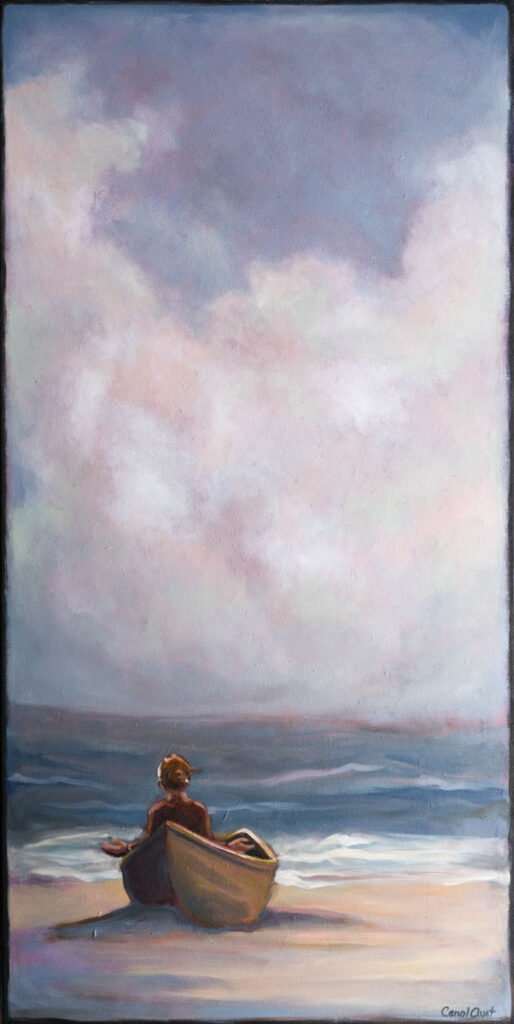
So I paint a woman in a boat on a beach, hands open, no oars. The painting is my prayer for our sailor as she embarks again. Many of my paintings begin as prayers.
Open Hand, acrylics on canvas, 60″x30″
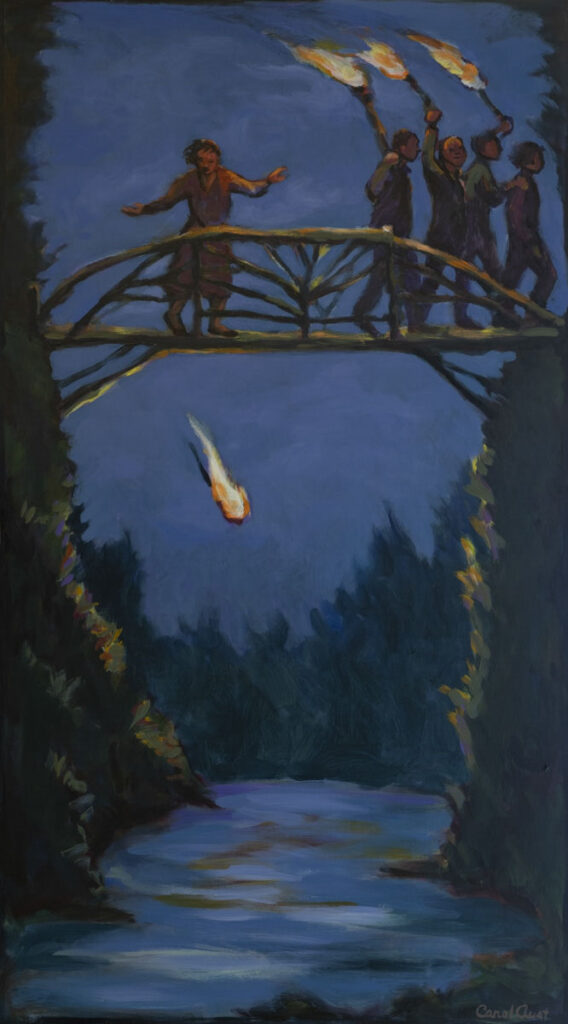
I paint a bridge across a canyon. I paint a woman on the bridge, arms open, eyes averted. It feels too passive, not right. I cover the woman with blue. I paint a woman striding forward. I don’t like that either. I paint a woman dropping her torch behind a night procession. My prayer is that the young adults in my life, my children and my guests, learn to separate from the world’s pressures when they need to.
Bridge in Torchlight, acrylics on panel, 45″x25″
Every afternoon I descend to the basement of my old house, a cup of tea in one hand, a plastic water carton with brushes in the other, to where my studio waits under old redwood beams that creak and moan during occasional earthquakes. Going down to the basement is like descending into my subconscious. In the big dim subterranean space, the lights focus on an easel. When I paint, I become completely absorbed. I step back and look at what I’ve painted, and then I move in close to paint more. The hours fly by.
To counterbalance my studio solitude I volunteer as a tutor with children and young adults, teaching them how to read. Unaccompanied minors, unhoused youth, teen moms from Yemen—it takes a miracle for them to learn how to decipher the words on a page.
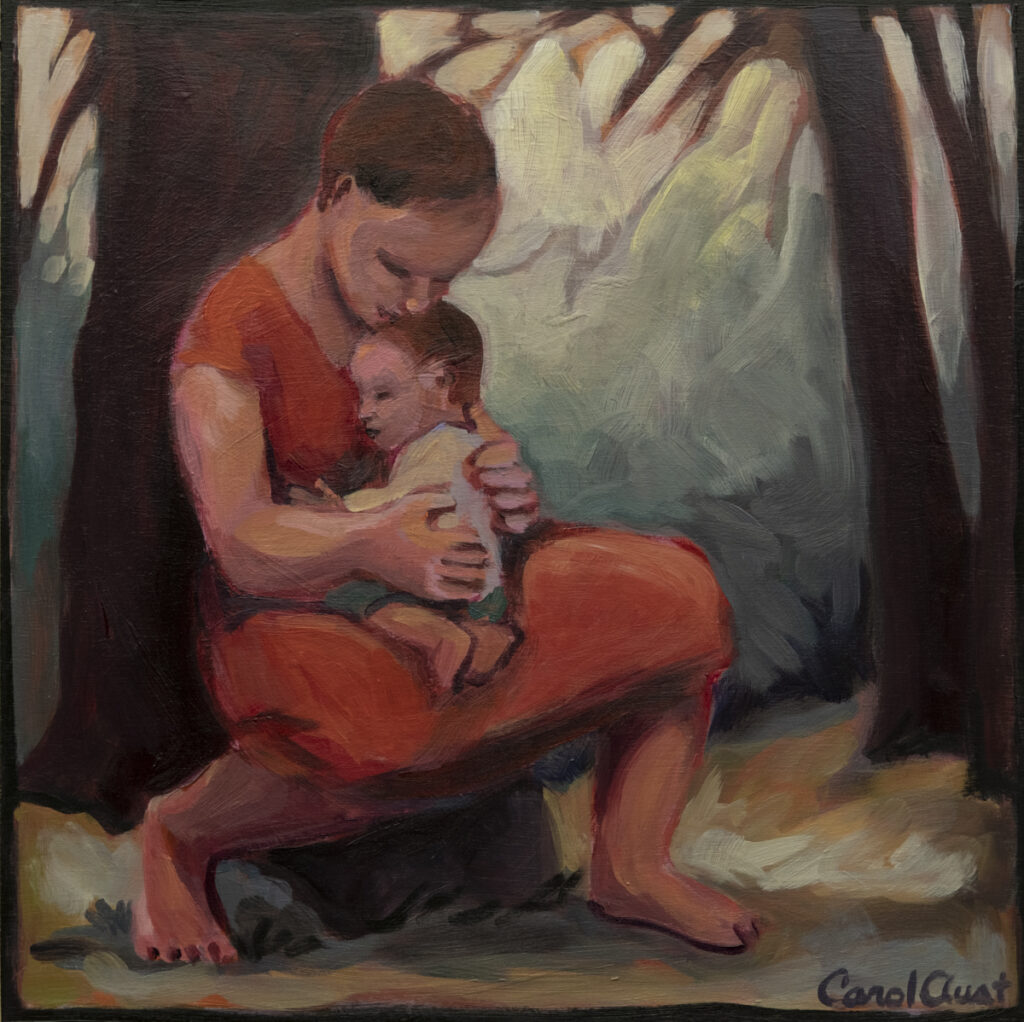
Later in the day, I put another panel on my easel and paint a mother and child, another prayer. As I paint it, I put my students in God’s arms. I rest in God’s arms, too.
Mother and Child #48, acrylics on panel, 14″x14″
There’s a second chapter to the paintings I make. Creating art is like raising children, and just as leaving home is a process, a painting isn’t necessarily finished once I sign the corner. In fact, its life has just begun. When a painting leaves my studio and elicits responses from viewers, the art becomes a living force in the world. Viewers of my work add the next chapter to the unfinished story, explaining why the woman is traveling alone, why the couple is dancing in the clouds, why the party is being held in the desert, what the particular painting means to them.
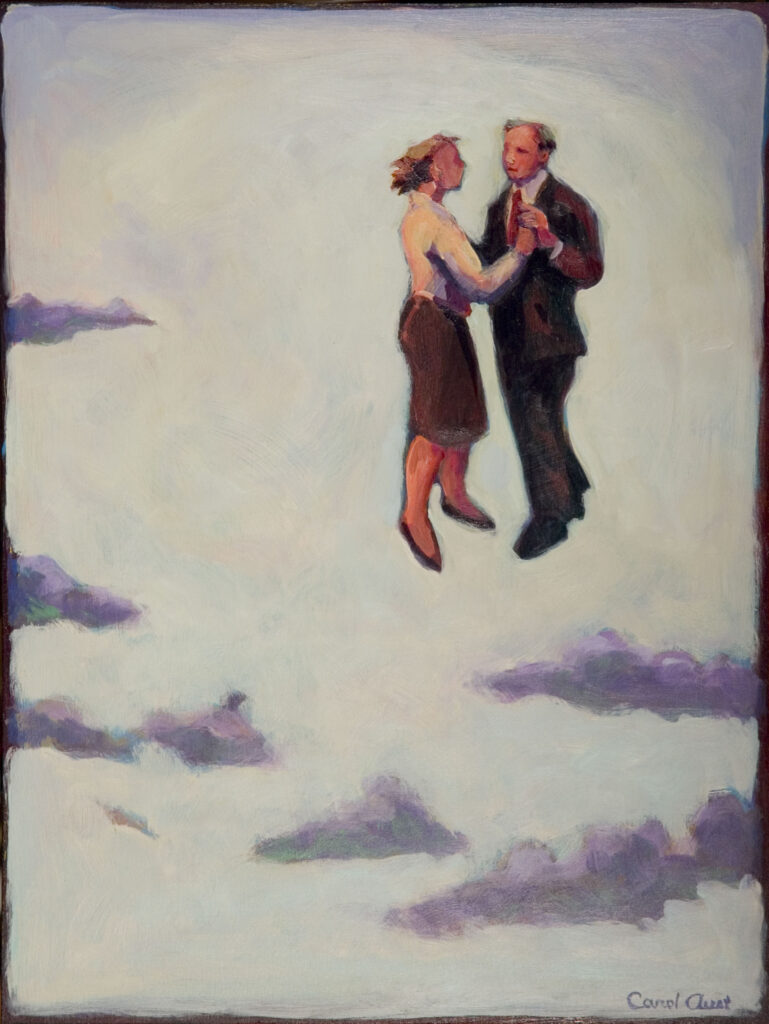
Years ago I painted a couple dancing and floating high among lavender clouds. I titled it No Visible Means of Support and hung it at an open studio. A couple approached me, and the wife said, “We need to have that painting,” gesturing to the dancers. I smiled and reached for my invoice book, but she stopped me and explained, “No, we really need that painting.” So I put the invoice book down and leaned in. She put an arm around her husband. “Mark had cancer this year and we had no visible means of support.” The painting changed and deepened at that moment; it became an instrument of healing.
No Visible Means of Support, acrylics on panel
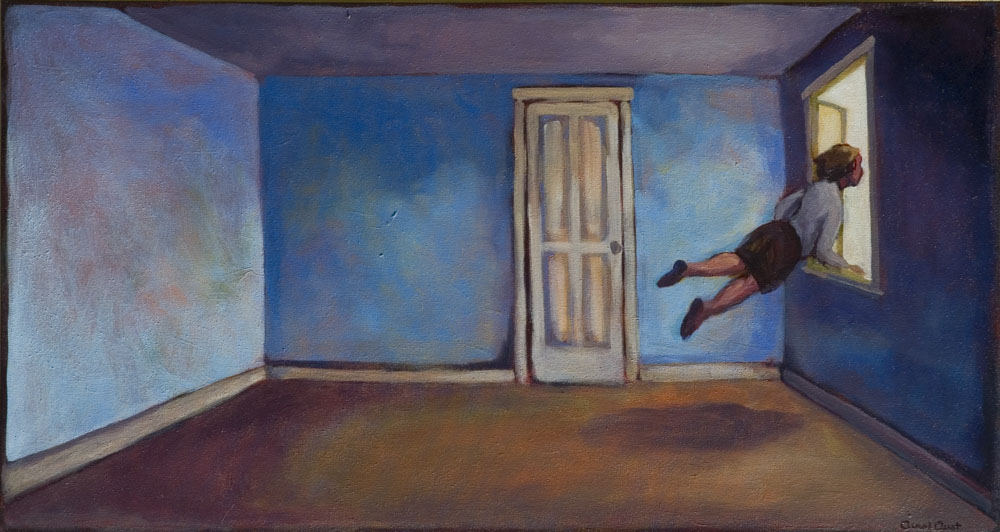
Another time, a woman called me and said, “I want to buy Out the Window, but you’ll need to deliver it to me because I’m in hospice.” I took the painting to a brown bungalow in the East Bay Hills, and someone led me to the living room where the woman who called me was reclining on a sofa. I rested the painting against an armchair, and we sat and looked at it together. It depicted a woman in a blue room, floating out of a window into a white sky. The woman said quietly, “My grandfather died by jumping out of a window after he returned from the war.” I paused and asked her if she wanted me to take it away. She answered, “No. I always thought that when I died I’d go into darkness, but as I look at this I realize I’ll go into light.”
Three weeks later, her friend called me and told me that the woman had died. I offered to take the painting back, but she said, “No, her husband wants to keep it. It comforts him.”
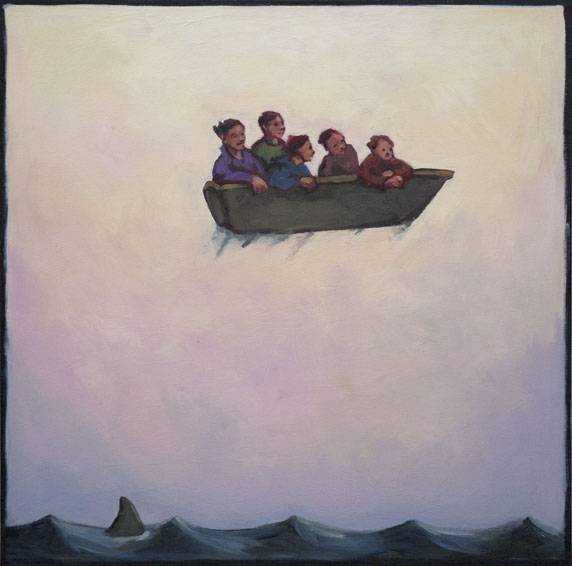
A few months later, a gallery director took some art of mine to a potential client, including a painting of a woman and four children in a flying boat. As she unloaded them in the client’s driveway, the woman gasped and explained that her husband had died suddenly a few years before, leaving her with four children and a large company to run. She took the painting and hung it in her bedroom in order to focus on the strength of the woman in the boat.
No Worries, acrylics on panel, 24″x24″
Often, I don’t hear the stories; I just see the tears. People will apologize as they dab their eyes and say, “I don’t know why I’m crying.” and I’ll respond, “That’s okay. It happens.” I know the art is touching a nerve, bypassing a wall they’ve erected.
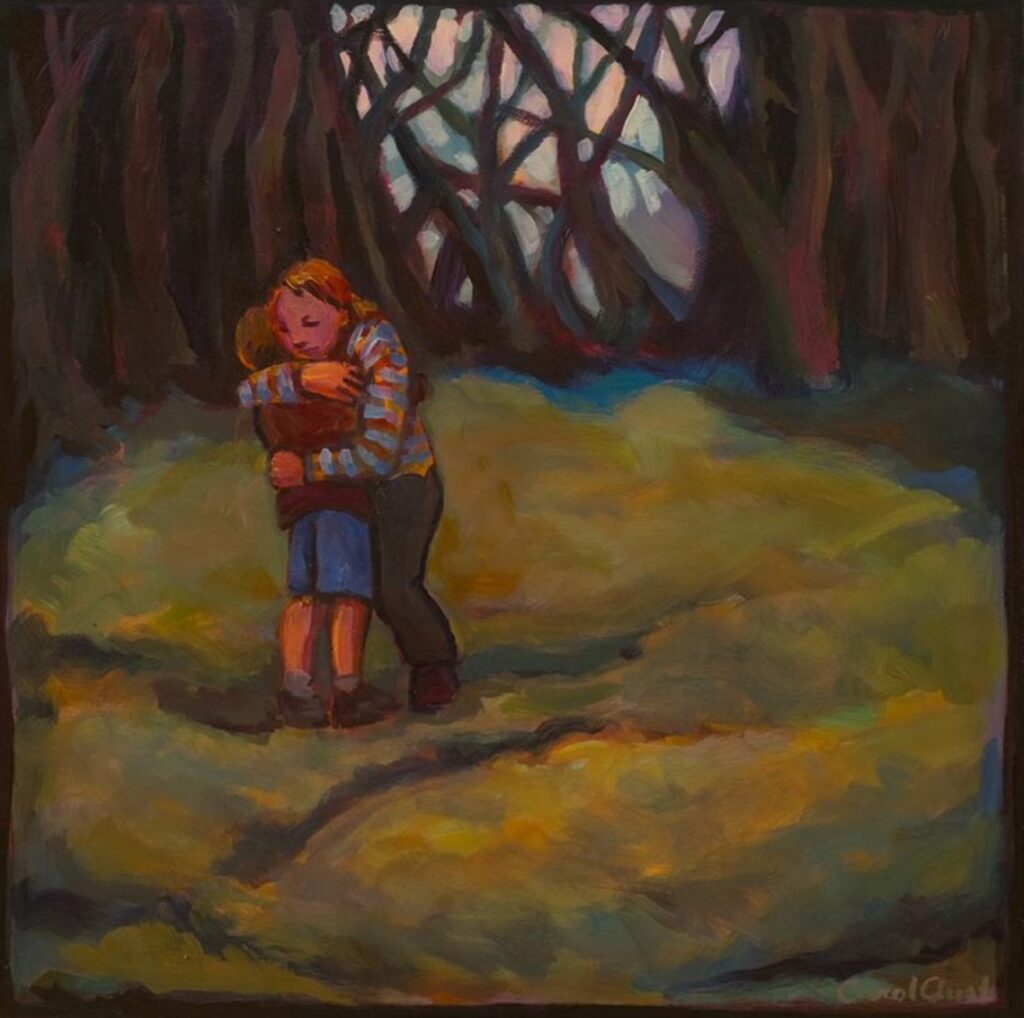
A member of my church bought one of my paintings of a mother hugging a girl at an auction. The next Sunday she explained through tears, “My mother died when I was eight. When I look at that painting I feel like God is holding me.”
Forest Hug, acrylics on canvas, 18″x18″
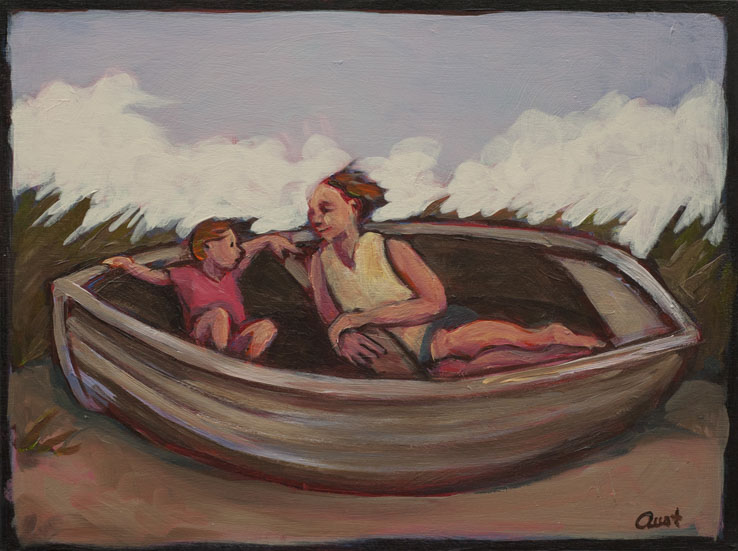
A woman wiped tears as she looked at Tell Me All About It, a picture of a mother listening intently to her child. “My mother listened to me like that,” she explained, and then paused and went on. “I just realized that today is the anniversary of her death.”
Tell Me All About It, acrylics on wood panel, 9″x12″
As an artist, I approach the canvas humbly and honestly. There’s no formula to follow. I’m not consciously trying to evoke emotions in the viewer, and I can never predict what paintings will touch people. Sometimes a piece of art will be unnoticed for years but then hit someone very miraculously. All I know is that if I’m faithful to God in painting my deepest truth, sometimes God uses the art to speak to people. The invisible becomes visible in a way that bypasses language. There’s a mystery here that I don’t understand.
In the dining room of our old house, I often extended the table by wedging an artist panel in the middle. For the five years before Covid, we would unlock our front door every Wednesday evening and put on a big pot of soup or a casserole, and fifteen to twenty-five friends (and an occasional delivery person) would come and dish up, laughing, arguing, and pushing their chairs back to make room as more guests arrived. It feels like a dim memory now. When the pandemic swept through our city and overflowed our hospitals, we kept our doors locked. I begin a new canvas, a canopy of trees with a golden opening in the distance. But what should I put in that archway moving towards the future? I paint a solitary woman carrying a suitcase. But I’ve painted her too many times these past years, so I cover her with pink. I paint a solitary woman on a bicycle, but I paint over her, too. I become so frustrated that I put the canvas away, facing the wall. I feel like a failure, like I’ll never paint anything good again.
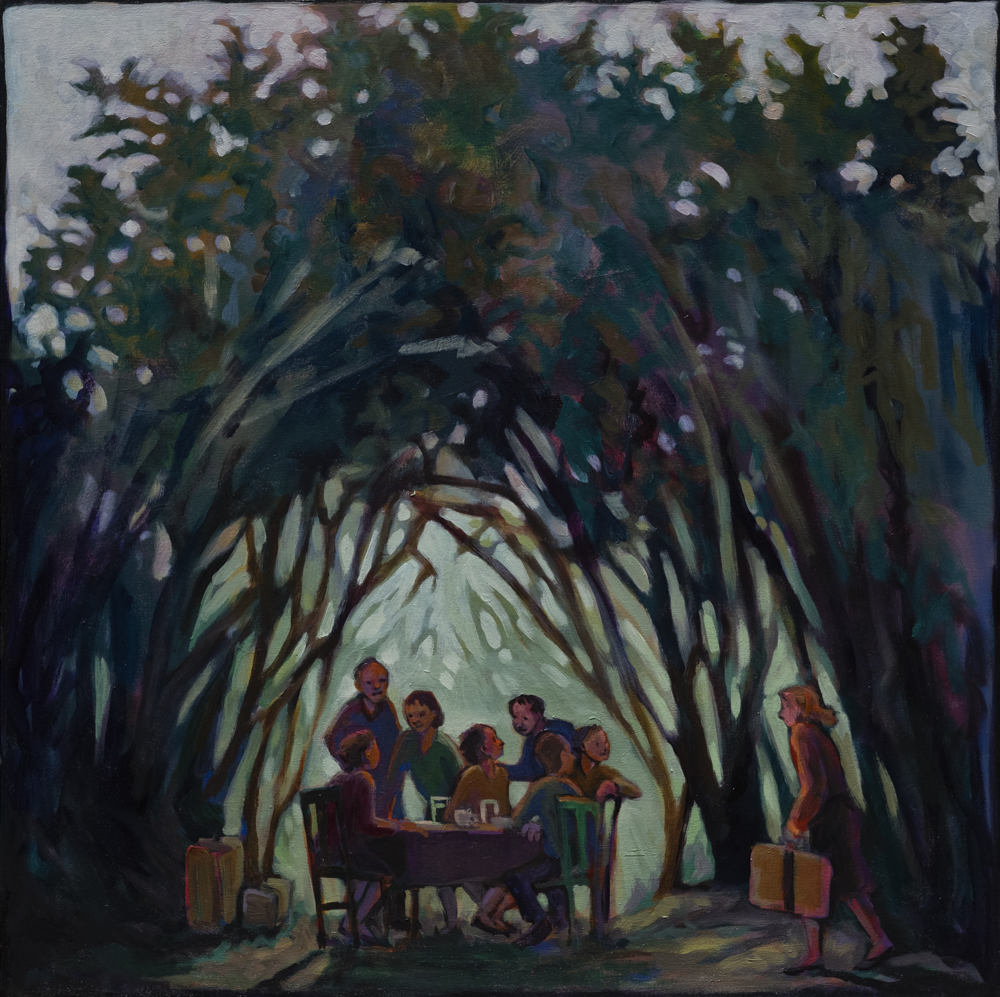
I wait a couple of weeks and pull it out, and then the miracle happens again. I paint a gathering of friends with suitcases piled nearby—not a big group, but one that’s beginning. It’s good enough, and I feel deep relief. But then I have to throw down my brush and run upstairs to start the soup. People are arriving for dinner soon.
Come As You Are, acrylics on canvas, 36″x36″
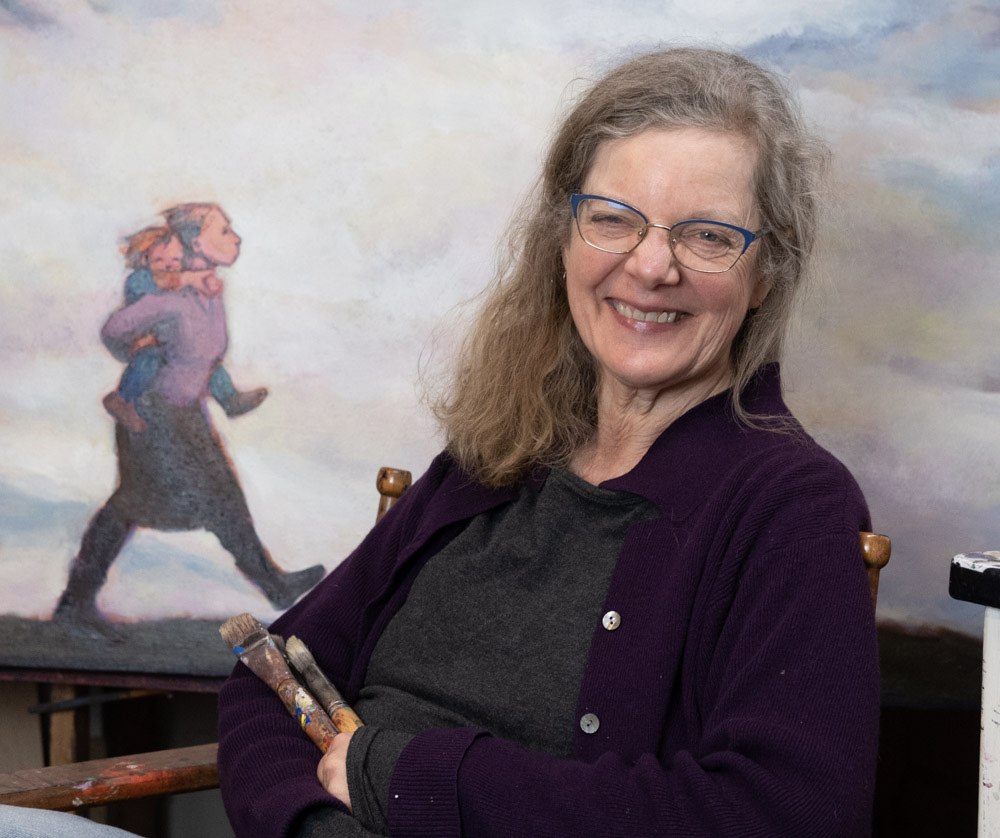
When I was a girl, my dad would take me and my brother and sister to San Francisco once a year. It was a big event, worthy of white lace anklets and black patent leather shoes. We'd ride cable cars and buy tiny sea shell baskets at Fisherman's Wharf. Then, as the fog rolled in and the neon signs flickered on, we'd walk through North Beach to a cafeteria my dad had liked since college. Across one big wall was a large mural depicting life in the City back in the 1930's, and Dad explained to us that it was a WPA mural. He told us that through the Works Progress Administration during the Depression, the government had paid unemployed artists to do all sorts of projects all over the country, like the murals in Coit Tower and mosaics on the UC Berkeley campus. We went back a few years later and discovered that the mural in the cafeteria had been replaced by large photos. We were indignant.
Ever since then, I've had a special place in my heart for WPA art. Last week in Washington DC, I saw these paintings in the Smithsonian. I love their accessibility, the way they captured real life.